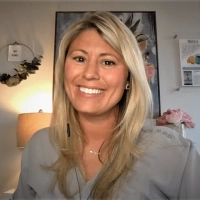When Have You Had to Pivot Your Business Strategy Quickly as a Business Leader?
In the ever-evolving landscape of business, swift adaptation and strategic pivots are not just beneficial—they're imperative. This article delves into the experiences of industry leaders who have swiftly redirected their business strategies to stay ahead of the curve. Discover expert insights on navigating challenges and seizing opportunities in a rapidly changing market.
- Pivot to Fractional COO Services
- Diversify Revenue Streams
- Transition to Digital Marketing
- Embrace Ethical AI
- Personalize Travel Packages
- Focus on Emergency Tree Services
- Add Done-for-You Services
- Shift to E-Commerce Solutions
- Expand to Startup Consulting
- Transition to Remote Work
- Adopt Usage-Based Insurance
- Adapt to Algorithm Updates
- Embrace Video Marketing
- Shift to Rental Property Management
- Invest in Digital Solutions
- Develop Virtual Onboarding Process
- Shift to Digital Channels
- Adopt AI-Driven Visualization
- Provide Full-Service Solutions
- Pivot to Digital Model
- Focus on PPC Campaigns
- Shift to Property Management Services
- Launch Virtual Services
- Create Virtual Tours
- Implement AI-Driven Tools
- Assist with Insurance Navigation
- Switch to Digital Model
- Adopt PPC Campaigns
- Focus on Rental Services
- Launch Virtual Services
- Create Virtual Tours
- Implement AI-Driven Tools
Pivot to Fractional COO Services
In my consulting business, I've always emphasized adaptability, but one particular pivot stands out. Initially, I positioned my services solely around operational strategy and process improvement. However, after working with multiple founders, I realized that many didn't just need structure-they needed a trusted right hand to help execute their vision while navigating growth challenges.
The shift to offering Fractional COO services happened quickly, driven by client demand and a clear market gap. Rather than just advising from the sidelines, I embedded myself within companies to implement strategies, optimize workflows, and help scale operations. This pivot required me to refine my messaging, adjust my service packages, and reposition my brand-but it ultimately led to deeper client relationships and stronger business outcomes.
The key takeaway? Listening to the market and acting decisively can turn an unforeseen shift into a strategic advantage.

Diversify Revenue Streams
Early in my career, when I was running my telecommunications company, I faced a significant challenge that forced me to pivot quickly. A major client unexpectedly decided to bring their telecommunications infrastructure in-house, which represented about 30% of our revenue. It was a wake-up call, and I knew the survival of the business depended on my ability to adapt. With my training in telecommunications from the army and my MBA in finance, I analyzed the situation and realized our dependency on a few key clients was a massive risk. I immediately shifted focus from relying on large clients to diversifying our revenue streams by targeting small to medium-sized businesses. I also invested in training my sales team to deliver a consultative approach, focusing on solving specific problems for these businesses rather than just selling services. Within six months, we signed over 50 smaller clients, not only recovering the lost revenue but also making the business more stable and scalable.
This decision came from my ability to stay calm under pressure, something I credit to my military training and years of working in high-stakes situations. My experience in understanding operational inefficiencies also allowed me to restructure our processes, reducing overhead by 15% while maintaining output. That pivot taught me the importance of agility in business and the need to constantly reassess the risks of your revenue model. It's this kind of strategic thinking and action that I now bring to the businesses I coach, helping them prepare for challenges before they happen and teaching them how to turn setbacks into opportunities for growth.
Transition to Digital Marketing
In my digital marketing agency, we had to pivot our business strategy quickly during the early months of the COVID-19 pandemic. As in-person events were canceled and businesses scrambled to adapt to the new normal, we saw a sharp decline in the demand for traditional advertising services, especially for live events and in-person conferences. Our clients in industries like hospitality, tourism, and retail were struggling, and we knew we needed to react fast to avoid a significant loss of revenue.
The decision to pivot came from closely monitoring market trends and conversations with our clients. We realized that the demand for online engagement, digital events, and e-commerce strategies was skyrocketing, while the focus shifted from physical presence to virtual presence. In response, we quickly transitioned our focus to providing digital marketing solutions tailored for online events, virtual conferences, and e-commerce growth. We also doubled down on offering services for businesses in need of virtual event planning, lead generation through social media, and online sales strategies.
The pivot involved rapidly retraining our team to be more adept at running virtual events and enhancing digital ad campaigns. We also adjusted our content strategy to address the changing concerns of our clients, offering webinars, virtual conferences, and tailored campaigns to help them stay visible and drive sales during the lockdowns. This pivot helped us retain key clients and even acquire new ones who were shifting their focus to e-commerce and digital channels.
By staying agile and listening to client feedback, we were able to adjust our approach and find new opportunities that not only helped us weather the storm but also positioned us for long-term success as businesses increasingly moved online. It was a clear example of how flexibility and being proactive can make a significant difference during times of crisis.

Embrace Ethical AI
At Marquet Media, a significant pivot occurred when we recognized a sudden industry shift toward ethical AI and hyper-personalization, driven by client demand and market trends. Focused initially on traditional PR and branding methods, we noticed through data analysis and client feedback that our audience increasingly valued innovative, data-driven solutions paired with transparency and ethical practices. This insight came during a particularly challenging quarter when engagement metrics began to plateau.
Recognizing an opportunity, we realigned our strategy to incorporate ethical AI into our service offerings, transitioning our teams toward specialized training and investing in the development of AI tools. The decision was driven by client expectations for cutting-edge services and our commitment to authenticity and integrity, ensuring that our pivot would meet market demand and remain true to our core values.
This shift had a positive impact on our business. Embracing ethical AI, we not only differentiated ourselves from competitors but also unlocked new revenue streams through innovative offerings tailored to the needs of our FemFounder audience. The pivot required agile decision-making and transparent client communication about the changes and benefits. The result was a noticeable increase in client satisfaction, improved campaign performance, and a tight-knit team culture eager to explore new possibilities. This experience reinforced the importance of staying attuned to market signals, being willing to adapt quickly, and ensuring that our foundational values and customer-centric approach underpin every pivot.

Personalize Travel Packages
At some point in my business journey, I realized my strategy wasn't addressing the changing needs of my customers. I was offering standard travel packages—predefined itineraries, fixed destinations—and I noticed a pattern in the feedback. Customers were looking for experiences that felt personal, like the trip was designed just for them. That forced me to reevaluate everything.
Instead of sticking to a one-size-fits-all approach, I dove deep into understanding my customers on a more personal level. I started to analyze their preferences, behaviors, and even their lifestyle choices. Psychographics became my guide. Were they adventurers looking for off-the-grid destinations? Families looking for convenience and comfort? Professionals looking for a mix of work and relaxation? By segmenting my audience based on these insights, I was able to design services that matched what they truly valued.
For instance, one segment of customers was all about sustainable travel. To meet that, I partnered with eco-lodges and designed itineraries that included conservation volunteering or guided nature tours. Another segment was urban explorers, and I created packages around local food scenes, art walks, and boutique stays.
This wasn't without its challenges. It required quick restructuring—new partnerships, new marketing, and a completely different approach to customer engagement. But the results were amazing. Customers felt heard and valued, which led to stronger relationships and raving referrals. Revenue also increased because the services resonated with people on a deeper level.
In hindsight, it wasn't just about changing the strategy; it was about being in alignment with what my customers wanted. I learned that when you listen to what people want and adapt to that, you don't just survive change—you thrive because of it.
Focus on Emergency Tree Services
In 2021, during the aftermath of a severe winter storm in Texas, Ponce Tree Services had to pivot our business strategy quickly to meet an overwhelming demand for emergency tree services. The storm caused widespread tree damage across the DFW area, with fallen limbs, uprooted trees, and hazardous conditions affecting countless properties. Traditionally, we balanced our workload between regular maintenance services like pruning and planting and larger projects like removals, but the storm created an urgent need for immediate hazard mitigation. I drew heavily on my years of experience as a certified arborist, particularly my TRAQ training, to quickly assess dangerous situations and prioritize safety for both homeowners and my team. We shifted our focus entirely to emergency response, implemented a 24/7 hotline, and restructured our crew schedules to handle the influx of calls.
This pivot not only allowed us to serve our community when they needed us most, but it also solidified our reputation as a reliable and responsive business. Our ability to adapt so quickly was a direct result of decades of industry knowledge and preparation. Having worked in the field since I was 10 years old and being involved in every aspect of the business, I understood how to mobilize resources, communicate effectively with customers in distress, and maintain high standards of service under pressure. By prioritizing safety, speed, and clear communication, we were able to turn a challenging situation into an opportunity to strengthen relationships with our clients and expand our customer base.

Add Done-for-You Services
We started purely subscription-based, thinking recurring revenue was the holy grail, but kept hitting a wall with larger clients who needed more hands-on help. The turning point came when we lost three enterprise clients in a month because we couldn't offer done-for-you services alongside our software. We mapped out exactly what these clients needed and realized we were leaving serious money on the table by being subscription-only. The pivot to adding done-for-you services doubled our average client value within three months because enterprise clients would happily pay premium rates for implementation help. We kept the subscription model for smaller clients but built out a complete service wing for enterprises, which now accounts for 60% of our revenue. The biggest lesson was that sometimes you need to let go of your perfect business model and actually listen to what customers will pay for.

Shift to E-Commerce Solutions
As the Founder and CEO of Nerdigital.com, I've experienced firsthand how quickly things can shift in the tech world. One example that stands out is when we had to pivot our business strategy during the early days of the COVID-19 pandemic.
In early 2020, we had a solid focus on offering digital marketing solutions and business consultancy to companies that were mostly in the retail and hospitality industries. But when the pandemic hit, those industries were hit hard, and many of our clients faced serious financial strain. Almost overnight, we realized that we had to shift our focus to stay relevant and keep our business moving forward.
We quickly pivoted to emphasize helping businesses transition to e-commerce, offering solutions like setting up online stores, optimizing digital payment methods, and helping clients launch remote working solutions. Our team worked around the clock to learn and implement the most effective tools for businesses that suddenly had to rely on digital-first strategies to survive.
The decision to pivot was driven by a combination of market need and our team's expertise. We saw that many businesses were unprepared for the sudden shift and needed help navigating the new digital landscape. This was the perfect moment for us to step in, providing value where it was most needed.
The result? Not only did this pivot help our business grow during a challenging period, but it also allowed us to forge deeper, more valuable relationships with clients. We provided them with the solutions they needed to survive and thrive during uncertain times, and as a result, many became long-term partners.
The lesson I took from this experience is that being adaptable and responsive to market changes is essential, especially in times of crisis. Flexibility, along with a strong understanding of your capabilities and your customer's needs, can lead to growth even in the toughest of times.

Expand to Startup Consulting
During my time leading spectup, our most significant pivot came early in 2022 when we noticed a concerning pattern among our startup clients. While we were excelling at creating pitch decks, I saw the same issue I'd witnessed at N26 and Deloitte - startups needed more than just presentation help, they needed comprehensive guidance on growth and investor readiness.
The real wake-up call came when two of our clients, despite having beautifully crafted pitch decks, struggled to secure funding because of underlying business model issues. This reminded me of my experience at BMW Startup Garage, where I learned that investor attraction goes far beyond just good storytelling - it's about having solid fundamentals and growth strategies in place.
We made the decision to expand our services beyond pitch deck creation to include full-scale startup consulting, drawing on my experience from different places where we handled comprehensive business strategy. It was a challenging transition - we had to quickly build out new service offerings, hire additional experts, and convince existing clients to trust us with more aspects of their business.
This pivot turned out to be crucial for both our clients and our business. The statistics showed that 38% of startups fail due to cash problems and 35% due to poor product-market fit - issues we could now address more comprehensively. Today, our expanded service offering has helped us create much deeper impact for our clients, leading to better success rates in fundraising and sustainable growth.

Transition to Remote Work
There was a time during the early months of the COVID-19 pandemic when we had to pivot our business strategy almost overnight. As a BPO, we were heavily reliant on office-based operations, and when lockdowns hit, it disrupted everything. Suddenly, we couldn't rely on the traditional models that had worked for us for years.
The decision to pivot was driven by two key priorities: keeping our teams safe and maintaining service continuity for our clients. Within a matter of weeks, we transitioned thousands of employees to remote work, something we'd never done at that scale before. It wasn't just about shipping laptops and setting up VPNs; it required rethinking how we managed, motivated, and communicated with our teams while ensuring client expectations were met.
One specific change was introducing new technology and tools to monitor performance and collaboration remotely. But beyond the tech, we focused on staying connected with our teams. Daily check-ins, virtual town halls, and real-time feedback loops became our lifeline.
This pivot not only allowed us to survive the immediate crisis but also reshaped how we think about flexibility and resilience in our business model. It was a tough period, but it reinforced the importance of being adaptable and putting people at the center of every decision.

Adopt Usage-Based Insurance
When COVID-19 disrupted traditional car usage, we noticed that customers wanted more flexible coverage based on actual miles driven. Our usual one-size-fits-all plans weren't cutting it, so we quickly shifted to emphasize usage-based insurance, partnering with a telematics provider to gather real-time driving data. Within weeks, we adapted our website to highlight these new options and built marketing campaigns around "pay-as-you-drive" messaging. That pivot attracted a wave of policyholders who'd otherwise have canceled or sought alternatives due to reduced driving habits. We saw higher retention and a 20% uptick in new policies, proving that reacting fast to evolving customer needs can pay off.

Adapt to Algorithm Updates
As a digital marketing agency, yes we've had to shift our own business strategy at lightning speed a few times—often due to Google's algorithm updates shaking up our metrics. These updates can have a profound impact on a site's rankings, traffic, and ultimately its sales. When one of these algorithm changes hits, it's important to be swift about making direction adjustments to safeguard your business outcomes.
For us, the process usually starts with a thorough audit to understand what parts of our client's SEO strategies have been negatively impacted—be it backlinking problems, lack of content relevance, or slow page speed. The critical thing has been to get ahead of the curve and know what the updates may be (or might represent) so that they won't surprise you when they arrive. SEO has always been changing and this process always seems overwhelming at first, but you do not want to be caught flat-footed. The investment in continuing good content and user experience has been the saving grace in coming to grips with these sudden shifts.
A good example is from our latest core algorithm update, where one of our e-commerce clients' traffic dropped massively—around 25%—all in one week. We quickly discovered that the main problem had to do with thin product category descriptions that were not informative enough for users. So, we rebuilt these pages to include keyword-rich content and optimized their internal linking structure for crawling. In under 30 days, their traffic not only recovered but was up 15% from their previous levels.

Embrace Video Marketing
The ability to swiftly adjust your business plan is essential for realtors to succeed in the dynamic real estate sector. To stay ahead of the curve, you need to be able to quickly adapt to new trends, technological developments, and market fluctuations.
Let's examine a real-world situation when I had to change my business plan and the factors that influenced my choice. A few years ago, there weren't many buyers, and the market was saturated with houses for sale. I was going through a difficult period as a realtor. Listings were staying on the market longer than usual, and my typical marketing techniques were not producing the expected results. All realtors were going through a difficult period, and I realized I needed changes in order to survive.
After conducting a market analysis and gaining insight into buyer behavior, I concluded that the conventional method of home selling would not be effective in this particular scenario. I had to think creatively and devise a fresh plan of action. That's when I decided to concentrate on video marketing. I began making high-quality videos of the houses I was selling and posted them on my website, social media accounts, and other platforms. I also started posting live-streamed property tours and virtual open houses.
It was difficult for me to decide to change my business plan. It required a substantial commitment of time, money, and effort. However, my clients were the driving force behind that choice. I understood that in order to stand out from the competition and attract potential customers in this competitive market, I would need to go above and beyond. I was able to present the properties in a unique and captivating manner thanks to the video marketing strategy, which attracted buyers and accelerated sales.

Shift to Rental Property Management
One particular instance that stands out is when the housing market took a sudden downturn. At the time, I was primarily focused on selling high-end luxury properties in a popular vacation destination. However, with the market crash, it became increasingly difficult to find buyers for these types of properties. It was clear that I needed to pivot my business strategy quickly in order to survive and thrive in this new economic climate.
The first step I took was to closely examine the current state of the market and identify any emerging trends or opportunities. I noticed that there was an increasing demand for rental properties, as people were not able to afford buying homes but still needed a place to live. This sparked an idea to shift my focus from selling properties to managing rental properties.
I quickly adjusted my marketing strategy and began promoting my services as a property manager. I also reached out to current clients who owned vacation properties and offered them the option of renting out their homes as a way to generate income during this tough time.
Invest in Digital Solutions
A client drastically reduced their marketing budget, forcing us to rethink their strategy. We shifted focus from paid campaigns to organic growth through content marketing and SEO. We kept their presence strong by identifying low-cost opportunities, like optimizing existing content and creating high-value guides. The approach was also a long-term investment, driving sustained traffic even after their budget bounced back.
Develop Virtual Onboarding Process
During the pandemic, we shifted focus to e-commerce clients overnight. Many traditional businesses paused, while online retailers needed immediate marketing expertise. We reallocated resources, tailored services, and launched Shopify-specific campaigns rapidly. This pivot kept our revenue steady and helped clients thrive in chaos. The sudden shift in consumer behavior demanded quick, decisive action. Brick-and-mortar closures pushed shopping almost entirely online without warning. Clients needed immediate help navigating this surge in digital competition. We adapted to serve their urgent needs and ensured mutual success.
Shift to Digital Channels
At Store-It Quick, one time we had to pivot our business strategy quickly was when we noticed certain areas were struggling with lower occupancy rates compared to others. After analyzing customer behavior and local market trends, we decided to launch a "50% off the first month" promotion in those specific locations to attract new customers. This decision was driven by the need to stay competitive and make our services more accessible during a challenging period. The promotion worked exceptionally well, boosting occupancy rates and bringing in long-term customers who appreciated the initial savings and stayed for the quality of our service. It was a great reminder that tailoring strategies to local market conditions can make all the difference in maintaining steady growth.

Adopt AI-Driven Visualization
We had to pivot our business strategy quickly when rising interest rates made long-term property holds less viable. Previously, our focus was on acquiring and holding properties for rental income, but as the cost of capital increased relative to market rents, the numbers no longer made sense.
To adapt, we shifted our strategy to short-term property acquisitions with the intent to resell on the open market. This allowed us to maintain strong cash flow, minimize exposure to changing market conditions, and continue growing the business without relying on long-term financing. The ability to recognize market shifts early and adjust accordingly was key to staying profitable.
Provide Full-Service Solutions
How We Adapted AI-Based Solutions to Meet Evolving Client Needs in Legal Outsourcing
A time when I had to pivot our business strategy quickly was when the demand for traditional legal outsourcing services started to shift as clients began focusing more on efficiency and cost-saving innovations.
I remember a conversation with a key client who expressed interest in AI-based solutions for contract review, something we hadn't yet explored. Realizing the growing demand for automation, we decided to pivot and invest in developing AI-powered tools for tasks like contract analysis and document redaction.
This decision wasn't easy, as it required both time and resources, but it paid off when we were able to offer faster, more cost-effective solutions that not only met client needs but also attracted new business.
This experience taught me the importance of staying attuned to market changes and being willing to pivot in order to stay competitive and deliver the best possible value to our clients.

Pivot to Digital Model
We had to pivot our business strategy quickly when market conditions shifted, and demand for appraisals in certain sectors, like agriculture, began to decline. This prompted us to diversify our focus toward the construction and transportation industries, where the demand for valuations was steadily growing. The decision was driven by conversations with clients who were navigating large equipment sales and acquisitions during a surge in infrastructure projects. To adapt, we developed industry-specific appraisal models that catered to the unique needs of construction and transportation clients. This required updating our database, refining valuation methodologies, and retraining our team to specialize in these areas. Understanding the nuances of this market allowed us to provide detailed and tailored reports that helped the client make informed decisions.

Focus on PPC Campaigns
We had to pivot quickly when we noticed a shift in client needs. While we initially focused on building custom websites, growing demand for mobile-friendly resources became impossible to ignore.
Client feedback and market trends made it clear: mobile-first solutions were the future. In response, we swiftly redirected resources to enhance our development capabilities, adopting cross-platform technologies to meet this demand.
This pivot not only kept us competitive but also unlocked new revenue streams and expanded our service offerings. This experience underscored the importance of staying agile and attuned to market shifts, proving that adaptability is key to long-term success.

Shift to Property Management Services
The decision to pivot our business strategy was not easy. It required careful consideration of various factors such as financial implications, potential risks, and the capability of our team. However, we knew that if we didn't take action quickly, our business could suffer greatly during a time of economic downturn. This realization was driven by market research and data analysis which showed a significant increase in online searches for properties in our area. We also noticed a decline in foot traffic at open houses and a decrease in responses to print advertisements.
To stay relevant and reach potential clients where they were actively searching, we made the decision to pivot our strategy towards digital marketing and online lead generation. We invested in creating a strong online presence through social media platforms, search engine optimization, and targeted digital advertisements. We also shifted our focus towards virtual tours and live streaming open houses to cater to the changing needs of clients during the pandemic.
The results were immediate and significant. Our website traffic increased, and we saw a surge in leads from online sources. By adapting quickly to the changing market conditions, we were able to stay ahead of our competitors and continue closing deals even during challenging times.

Launch Virtual Services
There was a time when I had to change my business plan quickly; it is very clear now. It was due to a supply chain failure that wasn't expected to happen, so we could no longer meet customers' expectations. The first thing I knew was that there was no staying still. I also looked to small local suppliers to help fill the gaps because I was pressured to keep their customer trust. It wasn't a simple choice (they had to shuffle the logistics and raise the price), but I thought it was time to ensure everything ran smoothly. It taught me that you can't be flexible in business, especially when the stakes are high. In retrospect, I'm grateful this quick shift covered our short-term demands and built solid bonds with our local partners, adding value to our supply chain that I had not expected. It showed me how strength can lead to serendipity.

Create Virtual Tours
There was a time when the housing market suddenly experienced a significant decline due to economic factors. This unexpected turn of events caught many real estate agents, including myself, off guard and forced us to rapidly pivot our business strategies.
The decision behind this sudden pivot was driven by the need to adapt and stay competitive in an unpredictable market. Our current strategy at the time was focused on selling high-end properties to clients with higher income levels. However, with the sudden decrease in demand for luxury properties, it became clear that we needed to shift our focus towards more affordable housing options.
To make this pivot successful, we had to quickly reevaluate our target audience and adjust our marketing tactics accordingly. We started targeting first-time homebuyers and individuals looking for more budget-friendly housing options. This meant changing our approach from promoting luxury features to highlighting affordability and value in our properties.

Implement AI-Driven Tools
One example of a quick business strategy pivot occurred when shifting market conditions highlighted a significant gap in our customer offerings. We noticed a growing demand for digital-first solutions, but our current offerings were heavily reliant on in-person interactions. This insight drove us to pivot rapidly by investing in technology to expand our digital capabilities. We launched virtual services and optimized our online platform to better meet customer needs. While it required immediate action and cross-team collaboration, the shift allowed us to stay competitive, attract new customers, and maintain strong relationships with existing ones. It was a clear reminder of the importance of agility and responding quickly to market demands.

Assist with Insurance Navigation
We had to quickly pivot our strategy during the early days of the pandemic when in-person client workshops were no longer feasible. To adapt, we developed a structured virtual onboarding process. Instead of lengthy Zoom calls, we broke sessions into shorter, focused segments spread across a few days. We also introduced tools like Miro to keep discussions collaborative and engaging.
The shift wasn't just about convenience; it ended up being more efficient for our clients. Many appreciated the flexibility of shorter sessions, and this new approach reduced scheduling conflicts. The experience taught us that sometimes, constraints force you to innovate in ways that improve outcomes. We've kept this hybrid model ever since.

Switch to Digital Model
The COVID-19 pandemic has caused significant disruptions in the real estate industry. When lockdowns and social distancing measures were put in place, it became clear that traditional methods of conducting business, such as open houses and in-person showings, would no longer be possible. This sudden shift forced me to quickly pivot my business strategy. One example of a time when I had to pivot my business strategy was during the height of the pandemic. As a real estate agent, I typically relied on face-to-face interactions to build relationships with clients and showcase properties. However, with restrictions on gatherings and travel, it was no longer feasible or safe to conduct business this way. To adapt to the changing circumstances, I shifted my focus to digital channels and virtual tours. I invested in professional photography and video services to create high-quality virtual tours for my listings. I also utilized social media platforms to connect with potential clients and showcase properties.

Adopt PPC Campaigns
One moment stands out when I reflect on the challenges we faced in the past and pivoted our business strategy. At an early stage of developing healthcare solutions, we realized that our solutions with traditional data visualization were no longer sufficient to meet the rising complexity of healthcare. For exponential growth, we need more intelligent and proactive tools that can deliver insights with visuals.
At this moment, I decided to pivot toward AI-driven data visualization. Trust me, it wasn't easy to shift from a traditional approach to a cutting-edge AI solution. I came into action with my leadership to redefine our processes and reallocate resources in the midst of an uncertain future. My vision behind pivoting was clear, I wanted our healthcare solutions to stay ahead of industry demands and help the clients manage the complexities of healthcare data.
As I hoped, we received remarkable results. I can still recall an instance where one of our major clients struggled to identify high-risk chronic patients in real-time. We integrated AI-powered visualization tools to allocate their resources effectively and improve patient outcomes by 30%. The decision to pivot positioned us as innovators in healthcare technology. One of the key lessons I learned is that it wasn't about changing or embracing new technology, but it was more about listening to our clients and their challenges. At OSP Labs, I believe that being a leader isn't just about steering the ship; it's about anticipating the waves.

Focus on Rental Services
The biggest issue was that homeowners suddenly couldn't qualify for coverage unless their roofs, windows, and doors met new hurricane protection standards. We had a backlog of projects, but customers were stuck waiting while they scrambled to find an insurer. In my case, the only way forward was shifting from a standard installation company to a full-service solution that helped homeowners navigate both construction and insurance at the same time.
The most important step was building partnerships with insurance providers that were still offering policies in Florida. We connected homeowners directly with agents who could guide them on the exact upgrades they needed to qualify for coverage. Since making that shift, we've helped over 2,300 homeowners secure insurance while completing their storm-proofing projects, which kept business moving despite the market downturn.
Launch Virtual Services
Our company's client acquisition strategy a few years ago was largely dependent on in-person events and conferences. All events were abruptly canceled when the pandemic struck, and we had to swiftly adjust. We switched to a purely digital model, emphasizing online consultations, webinars, and virtual workshops, rather than attempting to wait it out. The decision was motivated by the pressing necessity to continue generating leads and preserving client relationships. We not only survived the transition but also discovered new methods to interact with a global audience by swiftly adopting digital platforms. Although the move was difficult, we learned how important it is to be flexible and creative when faced with unforeseen setbacks.

Create Virtual Tours
We once transitioned from SEO-focused strategies to PPC-first campaigns for clients. A key Google algorithm update tanked rankings for some of our industries. We moved resources to paid search to regain visibility immediately for affected clients. This quick pivot protected their traffic and kept conversions stable.
The unpredictability of algorithm updates can leave businesses vulnerable overnight. Organic recovery takes time, but PPC offers instant visibility and control. Clients' needs were too urgent for us to wait for SEO recovery. The decision was about staying proactive, not reactive, to changing landscapes.

Implement AI-Driven Tools
The real estate market is constantly changing and evolving, and as a real estate agent, I have faced numerous challenges in my career. One particular challenge stands out - the sudden shift in the market due to unexpected events. One such example was during the global financial crisis of 2008. The housing bubble had burst, and the real estate market was facing a significant downturn. As an agent, I saw a drastic decrease in property sales and listings, and it became increasingly difficult to secure new clients.
In light of this challenging situation, our team had to quickly adapt and pivot our business strategy. We knew that we needed to make changes in order to survive and thrive in the market. After thorough research and analysis, we identified that there was still a demand for rental properties. People were struggling to obtain loans and mortgages, but they still needed a place to live. This led us to shift our focus from buying/selling properties to property management services.









